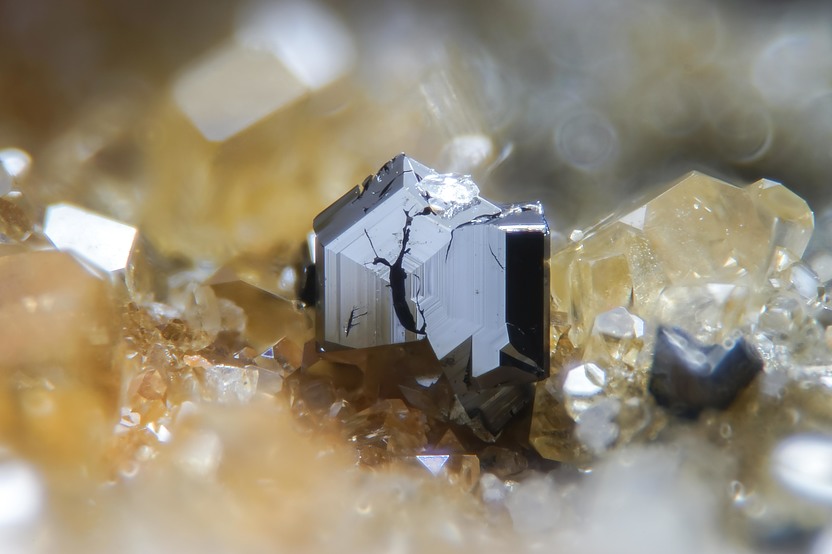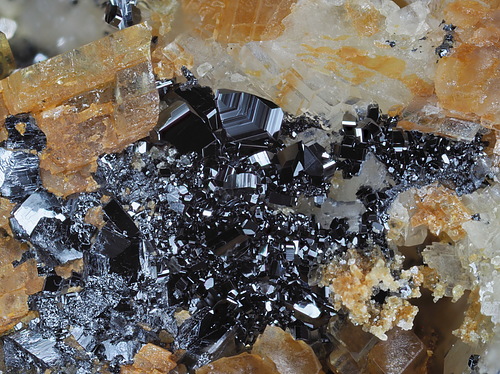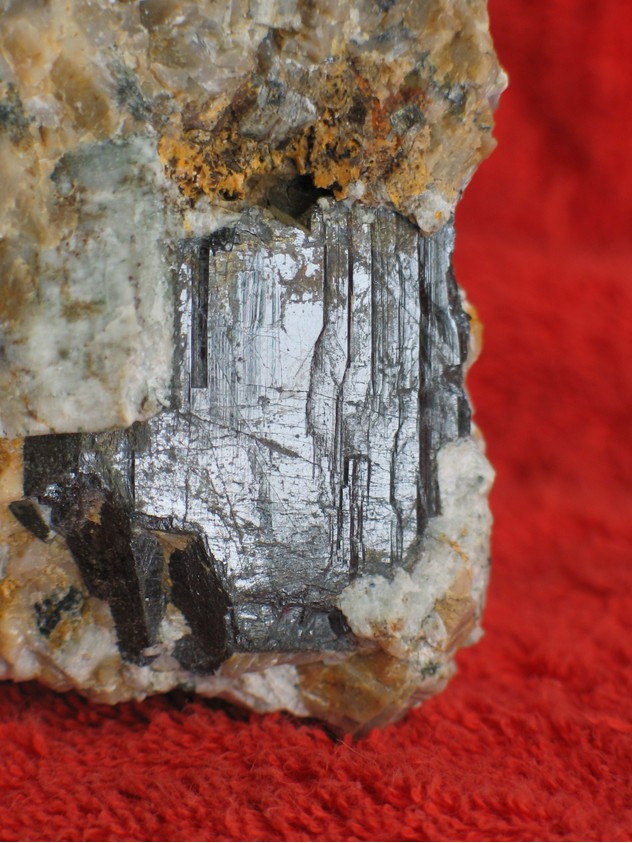Graeserite
A valid IMA mineral species
This page is currently not sponsored. Click here to sponsor this page.
About Graeserite
Formula:
Fe3+4Ti3As3+O13(OH)
also given as Fe2+xFe3+4-2xTi4+3+xAs3+O13(OH)
Colour:
Black
Lustre:
Metallic
Hardness:
5½
Specific Gravity:
4.56 (Calculated)
Crystal System:
Monoclinic
Name:
Named in 1998 by M. S. Krzemnicki and E. Reusser in honor of Dr. Stefan Graeser (1935-), professor at the Mineralogical-Petrographic Institute, University of Basel, Switzerland in recognition of his extensive research on the oxides and sulfosalts of arsenic in the Binntal region of Switzerland.
Type Locality:
Unique Identifiers
Mindat ID:
6977
Long-form identifier:
mindat:1:1:6977:5
GUID
(UUID V4):
(UUID V4):
cc82f267-e361-4b60-8cce-cc467914320a
IMA Classification of Graeserite
Approved
First published:
1998
Classification of Graeserite
4.JB.55
4 : OXIDES (Hydroxides, V[5,6] vanadates, arsenites, antimonites, bismuthites, sulfites, selenites, tellurites, iodates)
J : Arsenites, antimonites, bismuthites, sulfites, selenites, tellurites; iodates
B : Arsenites, antimonites, bismuthites; with additional anions, without H2O
4 : OXIDES (Hydroxides, V[5,6] vanadates, arsenites, antimonites, bismuthites, sulfites, selenites, tellurites, iodates)
J : Arsenites, antimonites, bismuthites, sulfites, selenites, tellurites; iodates
B : Arsenites, antimonites, bismuthites; with additional anions, without H2O
Mineral Symbols
As of 2021 there are now IMA–CNMNC approved mineral symbols (abbreviations) for each mineral species, useful for tables and diagrams.
| Symbol | Source | Reference |
|---|---|---|
| Gsr | IMA–CNMNC | Warr, L.N. (2021). IMA–CNMNC approved mineral symbols. Mineralogical Magazine, 85(3), 291-320. doi:10.1180/mgm.2021.43 |
Physical Properties of Graeserite
Metallic
Transparency:
Opaque
Colour:
Black
Streak:
Black
Hardness:
5½ on Mohs scale
Hardness:
VHN25=521 kg/mm2 - Vickers
Tenacity:
Malleable
Cleavage:
Distinct/Good
Moderate on {100}.
Moderate on {100}.
Fracture:
Conchoidal
Density:
4.56 g/cm3 (Calculated)
Optical Data of Graeserite
Bireflectance:
None.
Reflectivity:
| Wavelength | R1 | R2 |
|---|---|---|
| 460nm | 20.1% | 20.8% |
| 480nm | 19.6% | 20.3% |
| 540nm | 18.7% | 19.3% |
| 580nm | 18.2% | 18.9% |
| 660nm | 17.5% | 18.1% |
Graph shows reflectance levels at different wavelengths (in nm). Top of box is 100%. Peak reflectance is 20.8%.
R1 shown in black, R2 shown in red
Colour in reflected light:
Grayish white.
Internal Reflections:
None.
Pleochroism:
Non-pleochroic
Comments:
A full-spectrum reflectance plot given in Krzemnicki and Reusser (1998).
Chemistry of Graeserite
Mindat Formula:
Fe3+4Ti3As3+O13(OH)
also given as Fe2+xFe3+4-2xTi4+3+xAs3+O13(OH)
also given as Fe2+xFe3+4-2xTi4+3+xAs3+O13(OH)
Crystallography of Graeserite
Crystal System:
Monoclinic
Class (H-M):
2/m - Prismatic
Space Group:
B2/m
Setting:
C2/m
Cell Parameters:
a = 5.0225(7) Å, b = 14.3114(18) Å, c = 7.1743(9) Å
β = 104.878(3)°
β = 104.878(3)°
Ratio:
a:b:c = 0.351 : 1 : 0.501
Unit Cell V:
498.39 ų
Twinning:
Common, parallel to c axis.
Comment:
example, Biagoni et al. (2020)
Crystal Structure
Load
Unit Cell | Unit Cell Packed
2x2x2 | 3x3x3 | 4x4x4
Unit Cell | Unit Cell Packed
2x2x2 | 3x3x3 | 4x4x4
Show
Big Balls | Small Balls | Just Balls | Spacefill
Polyhedra Off | Si Polyhedra | All Polyhedra
Remove metal-metal sticks
Big Balls | Small Balls | Just Balls | Spacefill
Polyhedra Off | Si Polyhedra | All Polyhedra
Remove metal-metal sticks
Display Options
Black Background | White Background
Perspective On | Perspective Off
2D | Stereo | Red-Blue | Red-Cyan
Black Background | White Background
Perspective On | Perspective Off
2D | Stereo | Red-Blue | Red-Cyan
View
CIF File Best | x | y | z | a | b | c
CIF File Best | x | y | z | a | b | c
Rotation
Stop | Start
Stop | Start
Labels
Console Off | On | Grey | Yellow
Console Off | On | Grey | Yellow
Data courtesy of the American Mineralogist Crystal Structure Database. Click on an AMCSD ID to view structure
| ID | Species | Reference | Link | Year | Locality | Pressure (GPa) | Temp (K) |
|---|---|---|---|---|---|---|---|
| 0015412 | Graeserite | Berlepsch P, Armbruster T (1998) The crystal structure of Pb2+-bearing graeserite, Pb0.14(Fe,Ti)7AsO12+x(OH)2-x, a mineral of the derbylite group Schweizerische Mineralogische und Petrographische Mitteilungen 78 1-9 | 1998 | Gorb, Binn valley, Western Alps, Switzerland | 0 | 293 |
CIF Raw Data - click here to close
X-Ray Powder Diffraction
Powder Diffraction Data:
| d-spacing | Intensity |
|---|---|
| 2.681 Å | (100) |
| 2.846 Å | (80) |
| 1.5825 Å | (50) |
| 3.117 Å | (30) |
| 2.029 Å | (30) |
| 2.495 Å | (20) |
| 2.225 Å | (20) |
Geological Environment
Paragenetic Mode(s):
| Paragenetic Mode | Earliest Age (Ga) |
|---|---|
| Stage 7: Great Oxidation Event | <2.4 |
| 47a : [Near-surface hydration of prior minerals] | |
| 47d : [Arsenates, antimonates, selenates, bismuthinates] |
Geological Setting:
Metamorphosed Precambrian calc-silicate gneissic rock in the footwall of a Zn-Fe-Mn orebody (Sterling Hill, NJ).
Type Occurrence of Graeserite
General Appearance of Type Material:
Needle-shaped (<10 µm thick, up to 5 mm long). Occasionally, occurs in radial aggregates.
Place of Conservation of Type Material:
Natural History Museum, Basel, Switzerland.
Geological Setting of Type Material:
In hydrothermal veins in a two-mica paragneiss.
Associated Minerals at Type Locality:
Synonyms of Graeserite
Other Language Names for Graeserite
German:Graeserit
Spanish:Graeserita
Common Associates
Associated Minerals Based on Photo Data:
| 3 photos of Graeserite associated with Fetiasite | (Fe3+,Fe2+,Ti)3(As2O5)O2 |
| 3 photos of Graeserite associated with Quartz | SiO2 |
| 2 photos of Graeserite associated with Chlorite Group | |
| 1 photo of Graeserite associated with Calcite | CaCO3 |
| 1 photo of Graeserite associated with Clinochlore | Mg5Al(AlSi3O10)(OH)8 |
| 1 photo of Graeserite associated with Rutile | TiO2 |
| 1 photo of Graeserite associated with Adularia | KAlSi3O8 |
| 1 photo of Graeserite associated with Hematite | Fe2O3 |
Related Minerals - Strunz-mindat Grouping
| 4.JB. | Cuyaite | Ca2Mn3+As3+14O24Cl |
| 4.JB. | Brattforsite | Mn19(AsO 3)12Cl2 |
| 4.JB.05 | Fetiasite | (Fe3+,Fe2+,Ti)3(As2O5)O2 |
| 4.JB.10 | Manganarsite | Mn3(As2O4)(OH)4 |
| 4.JB.15 | Magnussonite | Mn2+10(As3+O3)6(OH,Cl)2 |
| 4.JB.15 | UM1984-09-AsO:ClHMn | Mn10As6O18(OH)Cl |
| 4.JB.20 | Armangite | Mn2+26(AsO3)14(HAsO3)4(CO3) |
| 4.JB.25 | Nanlingite | Na(Ca5Li)Mg12(AsO3)2[Fe(AsO3)6]F14 |
| 4.JB.30 | Asbecasite | Ca3(Ti,Sn4+)Be2(AsO3)6(SiO4)2 |
| 4.JB.35 | Stenhuggarite | CaFeSb(AsO3)2O |
| 4.JB.40 | Trigonite | Pb3Mn2+(AsO3)2(HAsO3) |
| 4.JB.45 | Finnemanite | Pb5(AsO3)3Cl |
| 4.JB.50 | Gebhardite | Pb8(As2O5)2OCl6 |
| 4.JB.55 | Derbylite | Fe3+4Ti3Sb3+O13(OH) |
| 4.JB.55 | Tomichite | (V,Fe)4Ti3AsO13(OH) |
| 4.JB.60 | Hemloite | (Ti,V3+,Fe3+,Al)12(As3+,Sb3+)2O23(OH) |
| 4.JB.65 | Freedite | Cu+Pb8(AsO3)2O3Cl5 |
| 4.JB.70 | Georgiadesite | Pb4(As3+O3)Cl4(OH) |
| 4.JB.75 | Ekatite | (Fe3+,Fe2+,Zn)12(AsO3)6(AsO3,HSiO4)2(OH)6 |
| 4.JB.75 | Szklaryite | ◻Al6BAs3+3O15 |
| 4.JB.85 | Lepageite | Mn2+3(Fe3+7Fe2+4)O3[Sb3+5As3+8O34] |
| 4.JB.90 | Bianchiniite | Ba2(TiV)(As2O5)2OF |
Other Information
Health Risks:
No information on health risks for this material has been entered into the database. You should always treat mineral specimens with care.
Industrial Uses:
None
Internet Links for Graeserite
mindat.org URL:
https://www.mindat.org/min-6977.html
Please feel free to link to this page.
Please feel free to link to this page.
Search Engines:
External Links:
Mineral Dealers:
References for Graeserite
Localities for Graeserite
Locality List
 - This locality has map coordinates listed.
- This locality has map coordinates listed.
 - This locality has estimated coordinates.
ⓘ - Click for references and further information on this occurrence.
? - Indicates mineral may be doubtful at this locality.
- This locality has estimated coordinates.
ⓘ - Click for references and further information on this occurrence.
? - Indicates mineral may be doubtful at this locality.
 - Good crystals or important locality for species.
- Good crystals or important locality for species.
 - World class for species or very significant.
(TL) - Type Locality for a valid mineral species.
(FRL) - First Recorded Locality for everything else (eg varieties).
- World class for species or very significant.
(TL) - Type Locality for a valid mineral species.
(FRL) - First Recorded Locality for everything else (eg varieties).
All localities listed without proper references should be considered as questionable.
Italy | |
| Biagioni et al. (2020) +1 other reference |
Switzerland (TL) | |
| Krzemnicki et al. (1998) |
USA | |
| Verbeek et al. (2006) |
Quick NavTopAbout GraeseriteUnique IdentifiersIMA Classification Classification Mineral SymbolsPhysical Properties Optical Data Chemistry Crystallography Crystal StructureX-Ray Powder DiffractionGeological EnvironmentType Occurrence SynonymsOther LanguagesCommon AssociatesStrunz-MindatOther InformationInternet Links References Localities Locality List








 symbol to view information about a locality.
The
symbol to view information about a locality.
The 





Passaic pit, Sterling Hill, Ogdensburg, Sussex County, New Jersey, USA